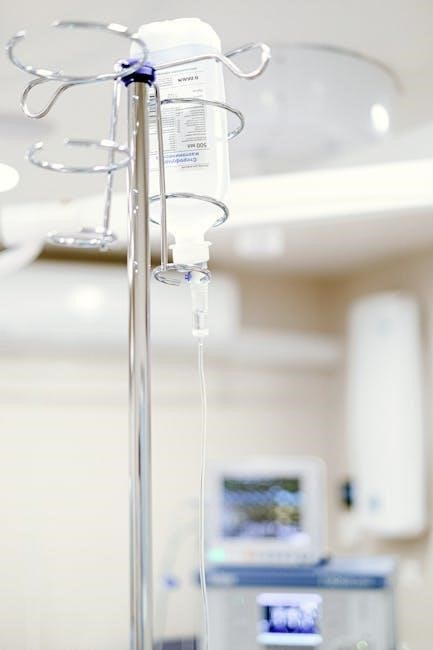Hospital patient menus are essential for ensuring nutritional care. Many hospitals offer Patient Menu PDF formats for easy access. QR codes provide digital menu viewing‚ enhancing patient convenience and transparency. These resources help meet diverse dietary needs‚ promoting recovery and satisfaction.
Overview of Hospital Patient Menu PDF
Hospital patient menu PDFs provide a structured and accessible way to present meal options for inpatients. These documents are designed to be easy to read and navigate‚ ensuring patients can make informed dietary choices. Many hospitals now offer digital versions of their menus via PDF format‚ which can be accessed online or through QR codes. These menus often include detailed meal descriptions‚ nutritional information‚ and options for therapeutic diets. They also highlight modifications for specific dietary needs‚ such as texture-adjusted meals for patients with swallowing difficulties. By offering both printed and digital versions‚ hospitals aim to enhance patient convenience and satisfaction. Regular updates ensure the menus reflect seasonal ingredients and patient preferences‚ making them a valuable resource for care teams and patients alike.
Importance of Nutritional Care in Hospitals
Nutritional care is a cornerstone of hospital treatment‚ directly impacting patient recovery and well-being. Proper nutrition helps patients heal faster‚ reduces complications‚ and improves overall health outcomes. Hospitals prioritize balanced meal options to meet diverse dietary needs‚ ensuring patients receive essential nutrients. Personalized diets‚ such as therapeutic and texture-modified meals‚ cater to specific conditions‚ enhancing recovery. Nutritional care also plays a role in patient satisfaction‚ as wholesome and appetizing meals boost morale. Additionally‚ clear meal plans and access to dietary information‚ like hospital patient menu PDFs‚ empower patients to make informed choices. Effective nutritional care is a critical component of holistic patient care‚ addressing both physical and emotional needs during hospital stays.

Designing Hospital Patient Menus
Hospitals design patient menus cyclically‚ considering each area’s patient count. QR codes and online access enhance convenience‚ allowing digital menu viewing and streamlining meal ordering processes.
Standard Normal Diet Samples
Standard normal diet samples are designed to provide balanced nutrition for patients. These menus often include options like shepherds pie‚ Thai chicken and ginger curry‚ and ham‚ egg‚ and chips. Meals are typically structured to include protein‚ fruit/vegetable‚ and grain/starch components. For example‚ breakfast might feature poached eggs‚ whole grain toast‚ and a selection of fresh fruits. Lunch and dinner options are similarly balanced‚ ensuring patients receive adequate nutrients for recovery. These samples are often published in hospital patient menu PDF formats‚ making it easy for patients to view and plan their meals. QR codes further enhance access‚ allowing patients to digitally explore menu options.
Therapeutic Diets and Modifications
Therapeutic diets are tailored to meet specific patient needs‚ ensuring optimal recovery and health management. Common modifications include liquid diets for post-operative patients and low-sodium options for cardiovascular conditions. Texture-modified meals‚ such as pureed foods‚ are designed for patients with swallowing difficulties. These diets are carefully balanced to provide essential nutrients while adhering to medical guidelines. Hospitals often publish these specialized menus in Patient Menu PDF formats‚ making them easily accessible. QR codes and online platforms further enhance convenience‚ allowing patients to view and select meals that align with their therapeutic requirements; This approach ensures personalized care and improves patient satisfaction during their hospital stay;
Meal Options for Patients
Hospital menus offer a variety of balanced meal choices‚ including main courses like shepherd’s pie and Thai chicken curry‚ alongside lighter options such as soups and salads.
Breakfast‚ Lunch‚ and Dinner Examples
Hospital patient menus provide balanced meal options throughout the day. Breakfast offerings include scrambled eggs‚ buttermilk pancakes‚ French toast‚ and breakfast potatoes. Lunch features dishes like shepherd’s pie with caramelised onion gravy‚ Thai chicken and ginger curry‚ and ham‚ egg‚ and chips. Dinner options include soups such as vegetable velouté or black bean soup‚ alongside balsamic asparagus salad and lemon coriander chicken salad. These meals are designed to meet nutritional standards and cater to diverse dietary needs. Patients can also choose from lighter options like house salads or soups with bread rolls. Many hospitals offer room service‚ allowing patients to order meals directly to their rooms‚ ensuring convenience and satisfaction during their stay.
Specialized Menus for Recovery and Swallowing Difficulties
Hospitals provide specialized menus tailored for patients with specific recovery needs or swallowing difficulties. These include texture-modified diets‚ such as pureed foods‚ soft cereals‚ and gentle soups‚ designed to reduce discomfort. Post-operative meals often feature light options like soups with bread rolls and house salads to aid recovery. For patients with dysphagia‚ menus may include thickened liquids and soft‚ easy-to-chew dishes. These meals are carefully prepared to ensure nutritional balance while catering to medical conditions. Portion sizes are calculated to meet health standards‚ ensuring patients receive the necessary nutrients for healing. Such specialized menus enhance patient comfort and support their recovery journey effectively.

Accessing Hospital Menus Digitally
Hospitals now offer digital menu access through QR codes and online platforms‚ allowing patients to view and order meals conveniently. This enhances transparency and patient satisfaction.
QR Codes and Online Menu Access
Hospitals are increasingly using QR codes to provide easy access to patient menus. By scanning these codes‚ patients can view digital menus‚ place orders‚ and access nutritional information. Online platforms also allow patients to browse meal options‚ check dietary restrictions‚ and customize their choices. This digital approach enhances convenience and transparency‚ enabling patients to make informed decisions about their meals. Additionally‚ QR codes often link to updated menu versions‚ ensuring patients receive the most current options. This innovative method streamlines the dining experience‚ making it easier for patients to navigate their meal selections during their hospital stay.
Room Service and Meal Ordering Systems
Many hospitals now offer room service models‚ allowing patients to order meals at their convenience. This system typically involves patients calling a dedicated number or using an online platform to select from the hospital patient menu PDF. Orders are processed and delivered within a specific time frame‚ ensuring freshness and efficiency. Patients can choose from a variety of options‚ including standard and therapeutic diets‚ tailored to their medical needs. This approach enhances patient satisfaction by providing flexibility and personalization. Some systems also allow visitors to purchase guest trays‚ further improving the overall dining experience. This modern method streamlines meal delivery while maintaining high nutritional standards.

Benefits and Challenges of Hospital Menus
Hospital menus ensure balanced nutrition and cater to diverse needs. However‚ challenges like food preferences‚ allergies‚ and maintaining high standards can complicate meal planning.
Nutritional Standards and Patient Satisfaction
Hospitals prioritize nutritional standards to ensure meals meet patients’ health needs. Portion sizes are calculated to align with dietary guidelines‚ promoting recovery and well-being. Digital tools like QR codes enhance patient satisfaction by providing easy access to menus and nutritional information. Offering tailored options accommodates diverse preferences and restrictions‚ boosting satisfaction. Patient feedback is crucial for refining menu designs and improving service quality. By balancing nutrition and taste‚ hospitals aim to enhance the overall patient experience‚ fostering trust and confidence in their care.
Challenges in Providing Balanced Meals
Providing balanced meals in hospitals faces several challenges‚ including managing diverse dietary needs and preferences. Supply chain disruptions can limit ingredient availability‚ affecting menu variety. Additionally‚ ensuring food safety while catering to patients with allergies or specific conditions requires meticulous planning. Logistical complexities arise when implementing room service systems‚ as timely delivery to rooms must be coordinated. Maintaining nutritional standards while offering appealing options is another hurdle. These challenges highlight the need for innovative solutions‚ such as flexible menu designs and advanced ordering systems‚ to enhance meal quality and patient satisfaction. Addressing these issues ensures that hospitals can deliver nourishing and enjoyable meals tailored to individual needs.
Hospital patient menus have evolved to prioritize nutrition‚ accessibility‚ and patient satisfaction. Digital formats like Patient Menu PDF and QR codes enhance transparency and convenience‚ aiding recovery and overall well-being.
Future of Hospital Patient Menus

The future of hospital patient menus lies in personalized nutrition and advanced digital integration. With the rise of QR codes and online access‚ patients will enjoy seamless menu navigation and ordering. Artificial intelligence will enable tailored meal plans based on individual health needs‚ while sustainability will drive eco-friendly food sourcing and packaging. Digital menus will reduce waste by optimizing meal production. Additionally‚ the integration of nutritional data with electronic health records (EHRs) will enhance care coordination. Patients can expect more interactive platforms for feedback‚ ensuring meals align with preferences and recovery goals. This evolution promises to improve satisfaction‚ outcomes‚ and operational efficiency in healthcare settings.
